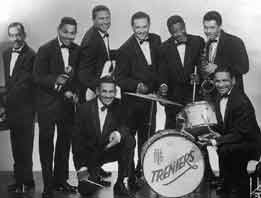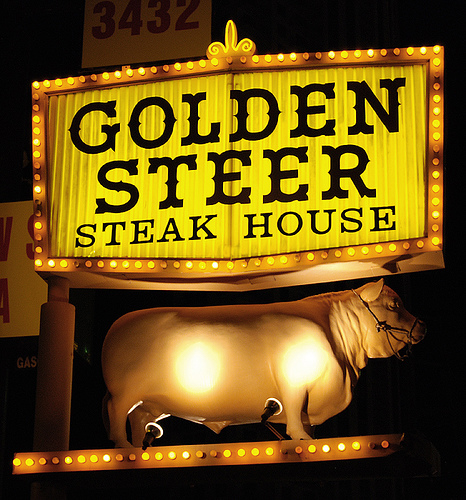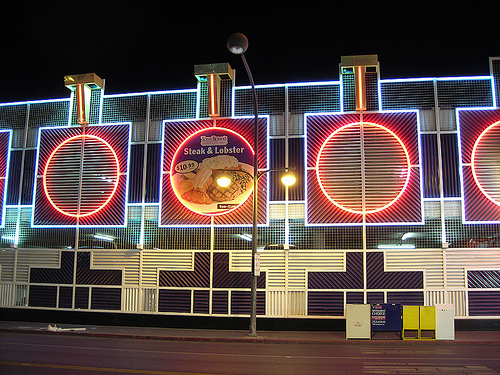Tours of Neon Boneyard suspended while work goes on
Up until now, tours of the Neon Boneyard were available by appointment. But beginning this week, tours have been suspended as the signs are temporarily moved so that work can begin on a park that will be part of the Neon Museum. From the R-J: Cranes took up position at the corner of Las Vegas Boulevard and McWilliams Avenue on Monday to start the delicate work of relocating vintage neon signs, the first stage in remaking the corner known as the Neon Boneyard. The relocation, to the Cashman Center parking lot next door, will be temporary while a half-acre park is built by Las Vegas. The Neon Museum, meanwhile, is moving forward with plans for a visitors center and a more organized exhibit of the accumulated neon treasures, including a walking path and a fence that is not made of chain link and barbed wire. "We don't want to lose the raw experience of the boneyard, but we do have to have a plan," said Danielle Kelly, the museum's operations manager. "The goal is for the whole boneyard to be open to general admission." Until now, tours of the signs were guided and by appointment only. Those tours are suspended for the duration of construction, which is expected to take 10 months. The museum is home to more than 150 neon signs from Las Vegas' past. There are huge ones, such as the Stardust sign, which is in nine pieces, or the Treasure Island skull that grins up at the sky (check it out on Google Maps). There are small ones, like the dancing shirt sign from Steiner's Cleaners or the leftover G, A, M, L and I from a "gambling hall" sign possibly dating from the 1930s. Their conditions vary. Some, like those lining parts of Las Vegas Boulevard north of Bonanza Road, have been painstakingly restored. Others have suffered from the elements and have cracked and peeling paint, rust spots and missing bulbs. Eventually, more of the signs might be restored, Kelly said. Some may just have the lighting fixed, however, leaving the wear and tear of history as is, and some will simply stay as they are. "We really honor the way they wear their history," Kelly said. "The peeling paint and the patina on them -- we think it's very beautiful. "It's about the story, really. ... The city is young. These things are historic, yet they're within the realm of our memory." The park is a $1.9 million project funded by the Southern Nevada Public Land Management Act, which sets aside money from public land sales to pay for parks and trails projects. Work on the museum's improvements is provided by grant funds and donations. The sign for Neon Boneyard Park will feature re-created letters from some of Las Vegas' most famous signs: N's from the Desert Inn and the Golden Nugget, an E from Caesars Palace and an O from Binion's.
City of Las Vegas breaks ground for new park for Neon Museum

The Neon Museum is about to get a big boost from the City of Las Vegas.
From the La Vegas Sun:
Spread over two lots in downtown Las Vegas, gated behind chain-link fences, sit more than 150 pieces of vintage Vegas. The relics belong to the Neon Museum, which has been collecting old signs since 1996 and showcasing them throughout the city and at its Neon Boneyard.
But with no place to adequately display its vast collection, the Neon Museum for years has been forced to operate on an appointment-only basis.
That will change with construction of the Neon Boneyard Park, which gets under way on Monday.
The park will be located on the corner of McWilliams Avenue and Las Vegas Boulevard and will back up to what is now part of the Neon Boneyard. The project has been nearly five years in the making, Public Works Project Manager Gina Venglass said.
The $1.9 million improvement project will include development of the half-acre park and paving part of the Neon Boneyard for a parking lot. The Bureau of Land Management funding the project.
When the park is completed, Venglass said, visitors will find landscaping, benches, picnic tables, a stage and informational kiosks.
A sign made up of replicas of old neon letters will welcome visitors to the new park.
The company building the sign, Federal Heath, chose iconic letters from the old Horseshoe, Desert Inn, Caesars Palace and Golden Nugget signs to spell out the word “neon” in LED lighting.
“It’s not going to be a park that visitors drive across town to use. It’s really supposed to work hand-in-hand with the Neon Museum for visitors to use,” Venglass said.
The park will be located along the section of Las Vegas Boulevard that was recently designated a National Scenic Byway and is at the heart of the Las Vegas cultural corridor.
The corridor includes a concentration of the city’s cultural institutions such as the Las Vegas Natural History Museum, Lied Discovery Children’s Museum, the Old Las Vegas Mormon Fort State Historic Park and the Reed Whipple Cultural Center.
“I think it’s a great example of how supportive the city is of the Neon Museum project and the cultural development of the downtown area,” Neon Museum Director of Operations Danielle Kelly said.
Because the city is resurfacing parts of the Neon Boneyard and moving signs in the process, it gave the museum the opportunity to bring its signs to the future fully-functioning museum, Kelly said.
The Neon Boneyard will move across McWilliams Avenue, behind the restored La Concha Motel lobby, which will serve as the visitor center.
The change will allow the Neon Museum to better serve visitors, expand public hours and operate under a general admission format, rather than visitors making appointments for tours, Kelly said.
In light of the construction, the Boneyard is closed to the public temporarily but will reopen in the spring for modified tours. The new facility should be up and running by the summer.
“So many great things are happening down here in the cultural corridor and downtown. We hope that the park is part of that,” Kelly said. “It’s is all a part of continuing to put energy into this area for people in the whole community to get some here and get to know their museums.”
Untold Stories this Thursday: African American Entertainers in Las Vegas

We kick off a the new year with our first "Untold Stories" on Thursday, February 4th with a look at African-American Entertainers in Las Vegas. We will discuss the early days of segregation up through what it is like to perform in Las Vegas today.
Panelists include:
Claytee White: Director of UNLV's Oral History Program
Skip Trenier: cousin to Claude and Cliff Trenier and member of the band
Audrey Henry: dancer with Debbie Reynolds and others
Sonny Turner: Lead singer of The Platters from 1960-1970
Michael Ryan Tyler: Musician who has played with Wayne Newton and others in today's Las Vegas
Thursday, February 4th, 2010
6:30 pm
Las Vegas Springs Preserve
Desert Learning Center
Admission $9
Discounts available if you buy a class pass!
Still a City of Neon

Will the Swim-In-Sign ever be repaired and put back up?

A tribute to Betty Willis and 50+ plus years of marketing
 Endangered
Endangered
 Pepe's Tacos great redaptive reuse of a former IHOP
Pepe's Tacos great redaptive reuse of a former IHOP
 Endangered
Endangered
 Tod Motor Hotel still going strong
Tod Motor Hotel still going strong
 Fremont Hotel Parking Garage
Fremont Hotel Parking Garage
Thanks to Allen Sandquist for letting us use these images
Nevada Supreme Court gives Pat Mulroy a major setback
Thanks to our pals at LA Observed for clueing us into Chance of Rain:
In a stunning reversal for Las Vegas water manager Patricia Mulroy, ground-water awards that were to fill an almost 300-mile-long pipeline planned by the Southern Nevada Water Authority to run from central eastern Nevada to Las Vegas were invalidated today. In an unanimous decision, the Nevada Supreme Court decided that the State Engineer violated the due process rights of hundreds, if not thousands, of people in target valleys across the Great Basin who had long protested the pipeline and water withdrawals.
After accepting to hear Great Basin Water Network vs State Engineer, the Nevada Supreme Court last spring issued this summary: “In 1989, the predecessor to the Southern Nevada Water Authority filed applications for unappropriated water rights from rural Nevada for use in Las Vegas. More than 800 interested persons filed protests. In 2005, the State Engineer notified roughly 300 of the interested persons that a prehearing conference would be held to discuss the water rights applications. Some organizations and individuals petitioned the State Engineer to re-notice the 1989 applications and reopen the period for filing protests. After the State Engineer denied the request, appellants filed a petition for judicial review in the White Pine County District Court. That petition was denied and appellants are now appealing that decision. [At issue:] Did the State Engineer deprive appellants of the right to due process and/or equal protection by refusing to re-notice the groundwater applications? Did the State Engineer violate his statutory duties by not ruling on the 1989 application within one year?”
In fact, as the legal protest period to the original 1989 applications neared closing in August 1990, the number of protests had surpassed 3,000. Most of these protestants were gone, broke or dead by the time the State Engineer began holding basin-by-basin hearings that would award water claimed under the applications more than a decade later.
In its decision issued earlier today in Great Basin Water Network vs the State Engineer, the Supreme Court of Nevada concluded that due process rights of the protestors had indeed been violated and that “the State Engineer violated his statutory duty by failing to take action within one year after the final protest date. Thus, we … remand for a determination of whether SNWA must file new groundwater appropriation applications or whether the State Engineer must re-notice SNWA’s 1989 applications and reopen the period during which appellants may file protests.”

In a written statement issued by the Great Basin Water Network, the attorney who brought the case, Simeon Herskovits, said, “The Court’s ruling clearly and forcefully affirms that powerful agencies like SNWA are not above the law that binds the rest of the citizenry, and that the State Engineer cannot arbitrarily give such agencies a pass on the law’s requirements.”
Also responding with a prepared statement, the Southern Nevada Water Authority called today’s ruling disappointing and added that it is “considering whether to file a Motion to Reconsider, because we believe the justices may not fully appreciate the far-reaching ramifications of their decision on people throughout the state.”
The Authority also questioned the fairness of singling out Las Vegas for a time lag when it contends that hearings for other applications are routinely not heard within a year of closing the protest period.
“While the decision was directed at the Nevada State Engineer’s ruling on our water right applications,” read the water authority’s statement, “the reality is that based upon an initial review of the state’s database, more than 1,800 applications are jeopardized by this ruling … it is not uncommon for it to take longer than 12 months to act upon a water right application.”
In light of today’s ruling, an agreement pending with Utah about how much water Nevada might be allowed to draw for the Las Vegas pipeline from Snake Valley, a basin shared by the two states, has also stalled, according to reports in the Utah paper the Millard County Chronicle Progress. “This ruling significantly changes the landscape upon which our ongoing discussions have been based,” Utah Governor Gary Herbert told the Chronicle Progress. “It allows us to revisit the proposed agreement with the State of Nevada and ensure that our continued desire to protect Utah’s water interests and the environment is met.”
Patricia Mulroy, who began her leadership of the Las Vegas Valley Water District in 1989 by stunning Nevada with sweeping groundwater applications in dozens of basins across the state, and who later led the formation of the Southern Nevada Water Authority, is in Washington DC today at a climate change conference, where she was expected to recommend exports of Mississippi River water to Southern Nevada as part of a large federal works project.
Photo provided by Chance of Rain


